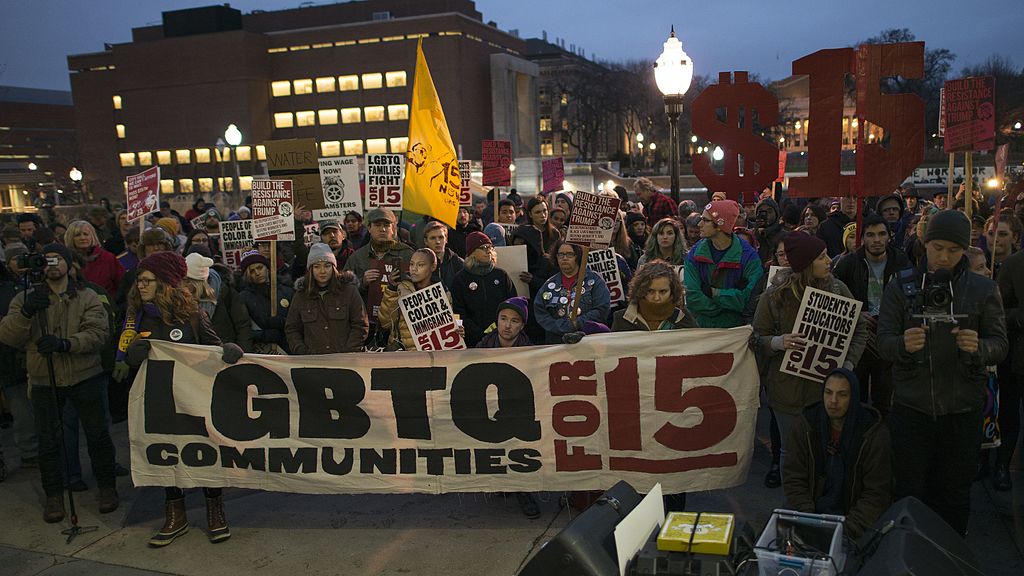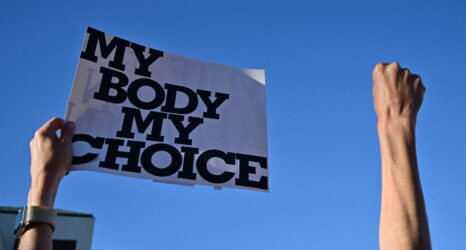The United States has never captured how many cents on the white male dollar LGBTQ+ people earn on average, a decision that has prevented meaningful policy to address disparities.

This article originally appeared on The 19th.
Every year, a series of equal pay days mark the time it would take women to catch up with the wages that white men earned the year prior. But for the LGBTQ+ community, that measure doesn’t exist.
Unlike other countries, the United States has never captured how many cents on the white male dollar LGBTQ+ people earn on average—a decision that has buried the experiences of queer Americans and prevented meaningful policy to address disparities. And a historic lack of data about economic outcomes for LGBTQ+ people has made it difficult to quantify the depth of the disparities.
LGBTQ+ Equal Pay Awareness Day—which falls on Wednesday this year, but is typically held at varying days during Pride Month—recognizes the gaps in pay for the queer community, and specifically the lack of political appetite to quantify them the way the United States does for other disadvantaged groups. Equal Pay Day for Black women this year is August 3, for example, because Black women earn 63 cents for every $1 white men earn, meaning it will take them until August 2021 to earn the same as white men did in 2020.
Like Black women, Latinas and all other marginalized groups, LGBTQ+ people encounter unique experiences in the American workforce that put them at a disadvantage economically. People at the intersections of race and gender suffer deeply, more so than their white counterparts. That is also true for LGBTQ+ people, and particularly transgender people.
According to a report from the Human Rights Campaign, 58 percent of transgender people of color reported their work hours were reduced during the pandemic—the highest figure out of any of the groups in the survey. For the general population it was 23 percent, and for white LGBTQ+ people the figure was 27 percent.
About 26 percent of transgender people of color became unemployed due to COVID-19, compared to 12 percent of people in general.
Surveys like that one and others from the Williams Institute on Sexual Orientation and Gender Identity Law and Public Policy or the Center for LGBTQ Economic Advancement & Research are the only sources of data that try to capture the LGBTQ+ economic experience in a timely way. But they work within a number of limitations: Sample sizes are often small and non-representative of the entire population. It’s also challenging to recruit respondents.
“Any data that we get is almost surely an undercount,” said Christopher Carpenter, a professor of economics and the director of the Vanderbilt LGBTQ+ Policy Lab. “It is very possible, but very difficult to know, that the people who choose not to tell you—those might be the most vulnerable people.”
Still, it’s clear that poverty rates for queer people are higher than the general population, a result of discrimination, underpay, and other practices that have made it more difficult for LGBTQ+ people to buy homes, for example, and build wealth. That was true before the pandemic.
A report from the Center for LGBTQ Economic Advancement & Research found that one in five LGBTQ+ workers earned less than $25,000 a year in 2019—1.5 times the rate of non-LGBTQ+ households. One in five LGBTQ+ households also said they were unable to afford all their monthly bills—1.4 times the rate for those not in the queer community.
During the pandemic, anecdotal data points to increased housing insecurity for LGBTQ+ people, experts said. Many college students, for example, who were sent home because of COVID-19 didn’t have supportive home environments to return to. Queer people were also more likely to live alone, leading to higher rates of depression and anxiety due to social isolation. Single-gender homeless shelters were a persistent barrier for nonbinary people.
But much of that is still not quantified. And what’s also unclear from the available data is how much trends change over time, how prevalent they are in certain subgroups and how those breakouts differ by gender identity, sexual orientation and race.
“I worry there are other kinds of disparities that we just don’t see because we don’t have the data,” said Lee Badgett, a professor of economics at the University of Massachusetts Amherst and one of the nation’s top experts on LGBTQ+ people and the economy. “We don’t really know very much about interventions—things that we can do beyond public policies that say you cannot discriminate. Let’s get beyond that. How do we actually turn them into powerful tools for equality?”
For Black cisgender women, for example, unemployment data is collected monthly, but the rate of unemployment for Black trans women is unknown. We don’t know the exact figure for the wage gap. We don’t even know precisely what jobs LGBTQ+ people are concentrated in. Much of that comes down to the questions surveys ask.
“We ask questions on these surveys about things that are important to people’s lives, and when we don’t ask about sexual orientation but we ask about sex and race and age, or when we have a question about sex that doesn’t include gender identity, people feel left out—like a part of who they are is not important,” Badgett said.
Capturing those identities are an economic imperative: Better understanding the disparities leads to more specific policies that could address those issues head on.
“If you don’t have the data, you won’t see the problems,” Badgett said. “If you don’t see the problems, you can’t do something about them.”
But for decades, the United States has been reluctant to collect the data, failing to put additional questions in the national surveys that are typically used to build a picture of the American economy. The jobs data that is released every month by the Bureau of Labor Statistics, for instance, makes no mention of nonbinary people, only seperating workers into men or women. It doesn’t divide any data out by sexual orientation. The American Community Survey, the U.S. Census Bureau’s demographic survey and the most comprehensive survey of the population, does not ask about sexual orientation or gender identity but does collect data on “same-sex couples.”
For years, this data has been all that’s available on the LGBTQ+ community, a severe limitation that omits a number of queer people.
Lack of political will has stymied efforts to change national surveys. The other challenge is logistical. Terminology in the LGBTQ+ community evolves, making including sufficient options that reflect all identities a particular challenge. Another difficulty is a knowledge gap for people who may select choices that inaccurately describe their sexual orientation or identity simply because they aren’t familiar with the terminology.
“People who do methodological research on these questions in the federal government, what they noticed was a lot of people who we would think of as being heterosexual, they don’t know what that word is,” Badgett said. “They might see bisexual and ‘bi’ sounds like two and go, ‘Maybe that’s what I am.’”
That has led groups to make changes to questions to remove heterosexual altogether and start the options with gay or lesbian to better prompt people. “Straight” or even “not gay or lesbian” have been put in place of heterosexual to gain more accurate results.
Other countries have found solutions, however. Canada, England, Wales and Chile are among the countries that will begin including a gender identity question in their censuses.
The Biden administration has reached out to LGBTQ+ economists like Badgett and Carpenter to better understand the lack of data on the community and opportunities for improvement. The administration also convened an Equitable Data Working Group to collect better disaggregated data on sex, gender and race. They have been meeting weekly since the start of the year, press secretary Jen Psaki told The 19th last month.
Carpenter attended one such meeting with the administration recently, which he said made him feel like “absolutely this is on their radar, it seems like a high priority [and] they are interested in hearing from people who are working on this.”
The Biden administration will also be working under new circumstances that may spur action. The 2020 Supreme Court ruling in Bostock v. Clayton County, a case that clarified that Title VII of the Civil Rights Act of 1964, which pertains to discrimination on the basis of sex, also extends to protect employees against discrimination on the basis of gender identity and sexual orientation.
Because of the lack of data, “we have no way of knowing how we’re doing in terms of compliance with a major Supreme Court ruling,” Carpenter said.
The avenues for measuring evidence of discrimination—comparing earnings, income, hours—are not there, but the case may encourage the federal government to seek it out.
“Without that information, the United States can’t even address a basic policy imperative,” Carpenter said. “I still think there is a social justice issue, I still think there is an equality issue, but now there is also this policy imperative that I think really compels the government to take a systematic approach to this data question.
Up next:





